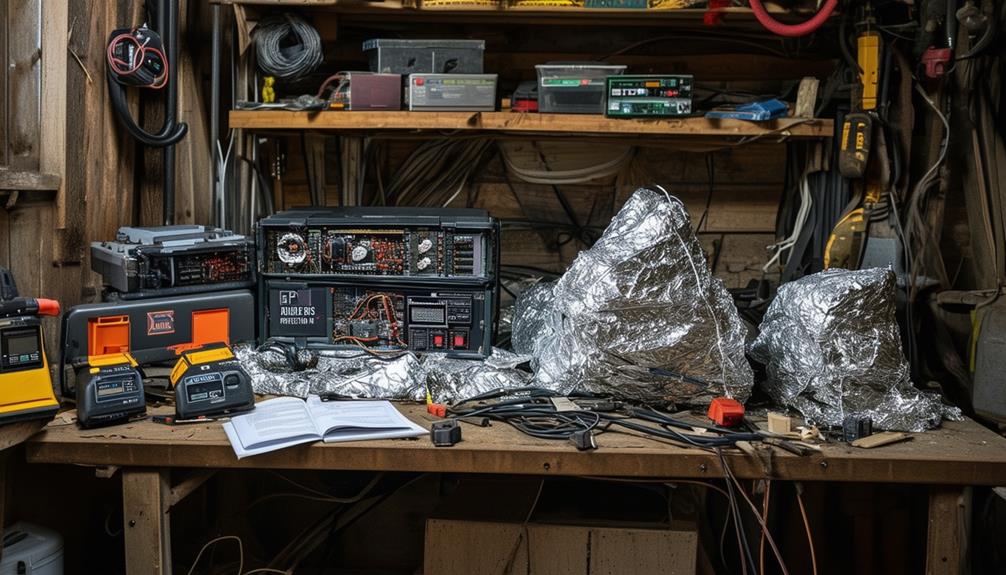Preparing for EMPs: Essential Steps to Protect Your Electronics

To safeguard your electronics from electromagnetic pulses (EMPs), understanding the potential threats is crucial. EMPs can severely damage sensitive devices, but you don't have to be an expert to take effective measures. Simple DIY solutions, like creating Faraday cages, can offer significant protection. For more robust shielding, investing in professional-grade options might be worthwhile.
Curious about which types of electronics are most vulnerable and how to effectively test your protective measures? Let's explore the specific steps you can take to ensure your devices remain safe and functional.
Understanding EMP Threats

How can you protect your essential electronics from sudden bursts of electromagnetic radiation, known as EMP threats? The initial step in developing effective protection strategies is understanding the nature of these threats. EMP threats, caused by nuclear detonations, solar events, or EMP bombs, release a powerful burst of electromagnetic radiation that can severely damage electronic systems.
These events can lead to both temporary and permanent power loss, disrupting everything from home appliances to critical infrastructure. To safeguard electronics, it's crucial to grasp the specifics of EMP threats. During an EMP event, the rapid surge of energy can overwhelm circuits and damage components, leading to potential irreparable harm.
Therefore, implementing tailored EMP protection measures is essential. For instance, using Faraday cages, surge protectors, and EMP shields can significantly mitigate the impact of an EMP event. These tools are designed to block or absorb electromagnetic energy, thereby protecting your electronics from damage.
Types of Vulnerable Electronics
Solid-state electronics, such as computers and mobile phones, are highly vulnerable to EMP attacks due to their sensitive components. In contrast, non-electric devices and solar panels are more resilient and less likely to be affected. Understanding these differences can help you better prepare and protect your essential electronics.
Solid-State Electronics Risks
Solid-state electronics, such as computers and smartphones, are highly vulnerable to EMP (Electromagnetic Pulse) attacks due to their reliance on microchips. An EMP can cause extensive damage to these devices, leading to complete system failures and loss of critical data. Identifying which electronics are at risk is essential for implementing protective measures.
Consider the following:
- Computers and Laptops: The microchips in these devices can be destroyed by an EMP, resulting in total system shutdown.
- Smartphones and Tablets: These devices depend on integrated circuits, making them particularly susceptible to EMP damage.
- Home Appliances: Modern appliances with digital controls, such as smart refrigerators and washing machines, are at risk due to their solid-state components.
- Network Equipment: Devices like routers and modems can be severely affected by electromagnetic pulses, disrupting internet connectivity.
To protect your electronics from an EMP, consider investing in EMP shielding solutions like Faraday cages and EMP-resistant storage. Proactive measures can prevent the costly replacement of damaged devices and the loss of important data. Preparation is your best defense against an EMP attack.
Non-Electric Device Resilience
When preparing for an EMP (Electromagnetic Pulse) event, it is crucial to recognize that non-electric devices are often much more resilient than their modern, solid-state counterparts. Devices that do not rely on complex electronics are less vulnerable to the damaging effects of an EMP. Analog watches, mechanical calculators, and manual appliances like wind-up radios and non-electric kitchen tools are prime examples of simple devices likely to survive an EMP.
Non-electric devices are generally more robust because they lack the fragile solid-state components that modern electronics possess. Vintage electronics, especially those with vacuum tubes, are better equipped to withstand EMP attacks. Similarly, mechanical tools and manual appliances do not depend on electricity, making them immune to the high-energy pulses an EMP emits.
To ensure preparedness for an EMP event, consider incorporating the following non-electric devices into your emergency plan:
| Device Type | Examples | Benefits |
|---|---|---|
| Timekeeping | Analog watches | No batteries or circuits needed |
| Calculation | Mechanical calculators | No dependency on electricity |
| Communication | Wind-up radios | Operates without power |
| Household | Non-electric kitchen tools | Simple, durable designs |
| Tools | Mechanical tools | No electronic parts |
DIY Protection Methods

Crafting your own EMP protection can be both practical and cost-effective, using simple materials like tinfoil, steel garbage cans, or even metal roofs. One of the most effective DIY methods is creating a Faraday Cage to protect electronics by blocking electromagnetic fields.
Here's how you can get started:
- Tinfoil Wrapping: Wrap your devices in multiple layers of tinfoil, ensuring there are no gaps. This can serve as a quick, makeshift EMP shield.
- Steel Garbage Can: Place your electronics inside a steel garbage can with a tightly sealed lid. The can acts as a large Faraday Cage.
- EMP Bags: Use Faraday bags specifically designed to block electromagnetic fields. These bags provide reliable protection.
- Metal Roofs: A metal roof can help shield an entire structure from EMP effects. Ensure all openings are sealed to maximize protection.
Professional Faraday Cages
For those seeking more robust protection than DIY methods offer, professional Faraday cages provide advanced shielding capabilities against EMP attacks. Companies like Underwater Kinetics (UK) design Faraday cages utilizing conductive plastic adhesive to ensure superior electromagnetic shielding. These cages meet stringent standards such as MIL-STD-464, guaranteeing effective protection for your electronic devices during an EMP event.
Investing in professional Faraday cages helps you safeguard your electronics from potential EMP damage. Unlike DIY solutions, these cages are engineered to withstand travel impacts and offer protection against dust and water. Their construction ensures electrical continuity, which is critical for top-tier shielding capabilities.
Purchasing from reputable suppliers such as UK ensures you're getting a product designed for long-term protection. Here's a quick comparison to help you understand the benefits:
| Feature | Professional Faraday Cages |
|---|---|
| Shielding Capabilities | Advanced (Meets MIL-STD-464) |
| Protection Against Elements | Dust and Water Resistant |
| Electrical Continuity | Guaranteed for Enhanced Protection |
Protecting Specific Devices

To protect your essential devices from the harmful effects of EMPs, you must employ a multifaceted strategy that includes proper storage, shielding, and maintenance.
Here are key methods to safeguard your electronics:
- Faraday Cage: Store sensitive equipment such as generators, solar panels, and medical devices in robust metal Faraday cages. These enclosures block electromagnetic pulses, preventing EMP damage.
- Grounding: Ensure metal enclosures for vehicles with solar equipment are grounded. Grounding dissipates EMP energy, providing an additional layer of protection for your devices.
- EMP Shield: Implement specialized EMP shields for critical infrastructure and electronic devices. These shields are engineered to absorb and deflect EMP waves effectively.
- RF Shielding: Apply RF shielding materials to critical appliances like refrigerators and freezers. This can be achieved using Faraday cloth and through regular maintenance.
EMP-Protected Rooms
Creating an EMP-shielded room, also known as a Faraday room, can significantly enhance your home's defense against electromagnetic pulses (EMPs). These specialized rooms protect electronics from the destructive effects of EMP attacks by using conductive materials to block electromagnetic radiation. Investing in an EMP-shielded room is a crucial step toward comprehensive electronic protection.
To build an effective Faraday room, consider the following key components:
| Component | Purpose |
|---|---|
| Conductive Materials | Block electromagnetic radiation |
| Grounding Systems | Redirect excess electrical energy |
| Sealed Entrances | Prevent radiation leakage |
These elements work in concert to ensure your critical electronic equipment remains safe during an EMP event. Typically, conductive materials like copper or aluminum are used to line the walls, floor, and ceiling of the room. Grounding systems are essential for redirecting any excess electrical energy away from sensitive devices.
Furthermore, home EMP shields can automatically disconnect your electronics from the grid during an attack, providing an additional layer of protection. By creating an EMP-shielded room, you significantly enhance your ability to protect electronics from potentially catastrophic damage, ensuring your home is prepared for any potential EMP event.
Testing and Selecting Equipment

When selecting EMP protection equipment, ensure the products are high-quality and sourced from reputable suppliers. Verify the manufacturer's reputation and seek warranties that attest to the effectiveness of their devices.
This strategy safeguards your electronics and ensures reliable performance during an EMP event.
Verifying Equipment Quality
Ensuring the quality of EMP safeguarding equipment requires rigorous testing and the selection of reliable products. To protect your electronic devices effectively, every piece of equipment, from EMP shields to comprehensive solutions, must meet high standards.
Here's what you should do:
- Thorough Testing: Ensure the devices have been tested under conditions that simulate EMP threats. This confirms their real-world effectiveness.
- Validate Manufacturer Credentials: Choose products from manufacturers known for their expertise in EMP protection. Check their track record and customer reviews.
- Purchase from Reputable Suppliers: Opt for EMP shields and other protective gear from reputable suppliers, as they typically offer high-quality, reliable equipment.
- Check for Warranties: Select products that come with strong warranties, providing assurance that the manufacturer stands behind their protection against EMP threats.
Reliable Supplier Selection
Selecting a reliable supplier is crucial to ensure that your EMP protection equipment is both effective and durable. To guarantee high-quality EMP shield devices, start by verifying the manufacturer's reputation and commitment to rigorous testing standards. Reputable manufacturers are known for producing dependable protection equipment through stringent quality control measures.
When choosing suppliers, prioritize those who offer warranted products. A warranty provides assurance that the EMP shield devices will perform as expected and maintain their durability over time. Trusted suppliers who stand by their products significantly impact the reliability of your EMP protection measures.
Testing EMP protection equipment independently can be risky and challenging. Therefore, relying on trusted suppliers who've already conducted necessary testing is advisable. These suppliers ensure their products can effectively safeguard electronics during an EMP event.
Conclusion
Understanding the threats posed by EMPs and identifying the types of electronics at risk is crucial. By employing DIY protection methods such as Faraday cages and EMP bags, along with investing in professional solutions, you can safeguard your devices effectively. It's also essential to test your protective measures and choose reliable suppliers. Taking these steps ensures you're well-prepared to protect your critical electronics from the damaging effects of an EMP. Remain proactive and secure your technology!




